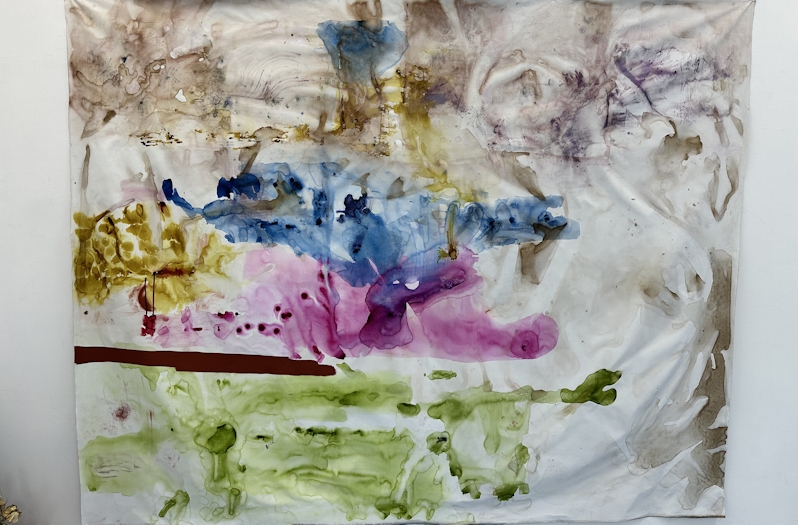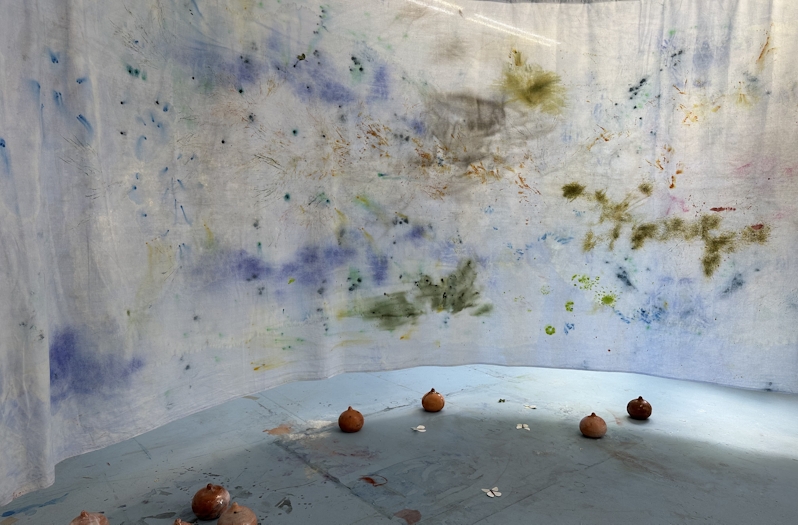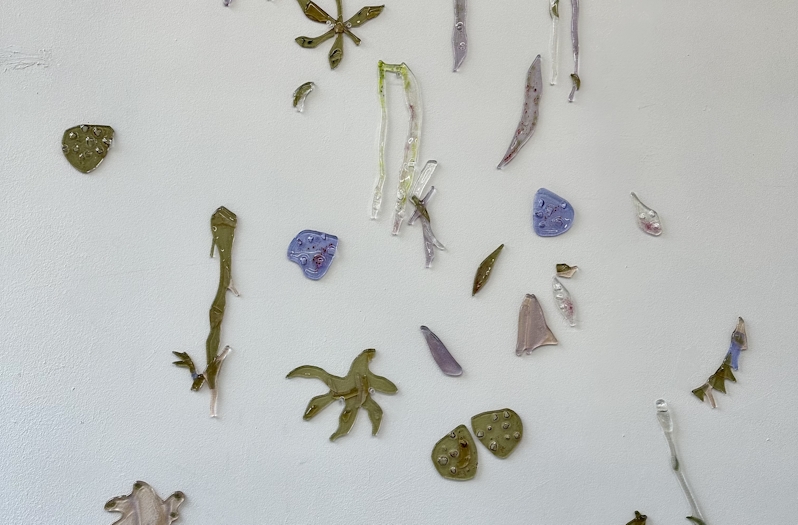tekst: 'Flowers for us all', about the work of Agnes Waruguru
The students of Robin Wall Kimmerer (a professor of environmental biology and the founding director of the Center for Native Peoples and the Environment) were united in their love for the earth; this passion was the reason they’d chosen to study botany. ‘But does the earth love you too?’ asked their lecturer. There was a long silence. They looked down, didn’t really know what to say.
A brilliant question, and one with far-reaching consequences when you give it further thought. It is not likely that the earth feels much love for us humans at the moment. Robin Wall Kimmerer offers wonderful insights that could change this.
She describes the earth as a system within which all the elements are positioned in a circle; each element is equal and is in a reciprocal relationship with the others. You should be able to see a plant as a person, which makes the relationship between you and the plant go far beyond an object that you are studying using a name and classification. Regarding a plant as a person does not mean an anthropomorphism like a Disney-esque talking cucumber but a plant being with plant characteristics, just as a stone is a being with stone characteristics. Kimmerer views plants as a gift from the earth and bearers of ancient knowledge. When we accept these gifts from the earth, the question arises of what we can give her in return. Where is that reciprocity?
In this way, plants can point us towards a different way of living together: giving more, taking less. For with people, it’s crystal clear: if others only take and give you nothing, you prefer to stay away from them. A gift is something that you hand over altruistically, whereas a real present inspires a feeling of gratitude, even love. A true present, perhaps one that someone has put a lot of time into, like a piece of embroidery or a hand-made mug, is something you carry in your heart and it creates a connection with the giver. But we take mother earth’s gifts for granted, we don’t give much back. On the contrary.

I believe the earth loves the work of Agnes Waruguru (1994, Nairobi, Kenya). In her practice, plants are both the starting-point and the centre. During the Rijksakademie Open Studios, a piece of fabric hangs free in the space, like a starry sky studded with sprigs of soft plant colours. The cloth is perhaps even more evocative of a glimpse below the surface of the sea, a tinge of light blue with green spatters, smudges and smears like seaweed, sea grass or kelp. The peace and tranquillity in the space is salutary, an oasis amidst the hustle and bustle of the other studios, a haven for reflection, a resting place. Butterflies have landed on the floor and there are ceramic calabashes below the fabric. On the left, against the wall, a plant has been placed under a drawing.
Earlier, I saw the work The Sea was Too Cold and Not Blue (2022) above a big heap of loose sand. Water Memories and Blooms (2022) hung next to it, consisting of two pieces of textile above each other: light blue spots stream downwards on the upper piece and the lower cloth resembles a green landscape filled with plant structures. (1)The landscape is important for Agnes Waruguru, not as an exact representation but in order to connecta particular emotion to a place. ‘In my work, I focus on trying to understand myself, the world I live in, where I come from, and how my identity is influenced by all the places where I spend time and travel through.’ That emotion may be an intense homesickness for her family and hometown, as she experienced while she was a student in California, USA. Or the emotion of a loss, the landscape borne within the quest for the soul of a loved one.

In Agnes Waruguru’s studio, I see two loose sheets of paper: a drawing of a flower that is built up of separate lines on the top piece of paper and, on the other, flowers appear from tiny lines in yellow, purple and blue with these words beside them:
Flowers for Thogori
Even when the body is no more
It will be back.
‘I … I am still looking for you.’
A photo of a girl in a blue dress with white dots, her hands clasped together in her lap. She is sitting on the edge of a bed draped with a white bedspread and is looking at the photographer with a melancholy expression. She is young. Gentle. Sweet.
Even if your body is no longer there, you will return.
I email Agnes Waruguru and ask whether it’s true that this work is an ‘in memoriam’. Could she tell me a bit more about it?
She responds with a detailed email that starts like this:
‘In the past two years I have been thinking about how to create spaces that are meditative and could hold space to encounter a spirit of someone past. I wanted to make a space that felt ephemeral but also grounding and calming. I asked many questions about how to represent an in between space where a spirit might exist. The works can also be seen as an offering or invitation.’

An artwork as an offering, as part of a ritual that began by washing the cloths in salt water. I am moved by her quest to offer a space to the spirit of the deceased. It is a giving gesture: Dear soul, I will help you to look for a place for you to come to so we can be together again for a while.
How do we go on living after the death of a loved one? That person will never leave us again. Present in our heart. In our thoughts. In our soul. Almost everyone who has lost a loved one knows that mixed feeling of the incomprehensible distance (never again will there be an embrace, never again a conversation) that coincides with an unbearable proximity, because the one who has left the earth is more present than ever before. This person dominates all our thoughts, grief flows through the body.
But sometimes the grief is unable to leave the body, and everything stagnates. When you walk through the city you see her or him or them appear in windows, in passers-by, in trees or reflected in a pond. Their voices can be heard.
Western science often calls hearing the voice of someone who has died a hallucination. ‘Hallucinations following a death are a normal reaction to a loss. Some people see their loved one so realistically that they talk to them.’ (4)
But science is very quick to label everything as obscure that cannot be explained. Maybe their souls really are present in our everyday reality, I daren’t rule it out. Waruguru probes this possibility with her artist’s imagination and explores what an in-between meeting place like this might look like.

‘I investigated how water can exist as an archive and also a healing tool. This idea came about after the passing of a dear friend. I spent a lot of time processing that I may never be able to talk to her again. I started to embrace the idea of looking for signs of her in my day-to-day life. This began with an exercise of collecting sounds of wind from one window in my house and while riding my bike around the city, I was looking for a moment where I could catch a sound or message that I would have otherwise missed. I connected this with the element of water that I have always been invested in. Where water never forgets and always remembers. The process is a repetition, an offering that transports.’
Artists Ellen Gallagher and Edgar Cleijne also integrate the idea of water as memory into their work Osedax. They refer to the many enslaved Africans who drowned during the Middle Passage, while crossing the Atlantic Ocean. These people were thrown overboard or jumped into the sea as the ultimate act of defiance. Their bodies sank to the bottom, and with them their stories, their heritage and knowledge were lost in the depths too. The water preserves their stories and, in the work Osedax, these stories are brought back to life. The voices of the drowned enslaved people resonate in the Osedax. (5)
Water is more than the formula H2O.
There are researchers like Veda Austin who are of the opinion that water can store concrete information: water as a conscious entity, connected with earth, connected with nature. She continues the work of the Japanese researcher Masaru Emoto who investigated the reaction of water to music and emotionally charged words. In his opinion, water possesses a real memory. His research is also widely criticised and I understand that, because I’m not sure that an emotional reaction fits with the properties of water. But the idea of water being more than a chemical formula is valuable.
Listening to water, to the plants, the river. What can we learn from them? Listening to the voices of the departed, simply for the sake of hearing their voices again, to pick up the conversation again.
Agnes Waruguru: I made ceramic calabashes as an end result to my exercise of collecting sounds. The work came from looking at my own tribal (Kikuyu) rituals surrounding death. I wanted to make something that reflected the way Kikuyu people are buried. Kikuyu people were traditionally buried in a foetal position facing Mount Kenya, usual in a family farm. The roundness of the calabash and its direct connection with sound is what led me to make these ceramic sculptures. They are named Ngomi (Song), which translates to ‘the eternally sleeping ones’ and is the word for someone who has left the earthly realm or passed on in Kikuyu.
When one becomes a nNgoma, one qualifies as an intercessor of kith and kin to the Gĩkũyũ people. Agnes Waruguru’s installations brought me into contact with the concept of ‘fleeting’, the continuous movement that characterises all of life. Even a stone contains a timespan that is stored away at the time of its creation. The flowers, the moments on the fabric, the photos of the girl who comes back again. The attention for everything that is alive. All her work exudes transience, temporality, gratitude in the form of beauty. I sense a perspective on the world that corresponds to Wall Kimmerer’s ideas.

‘The process of making these installations and works is a remembering repetition and cleansing. Held with care and slowness. Waiting,’ says Waruguru.
If I interpret her work as a gift to me and the rest of the world, what is the reciprocity between me and the work? How can I listen to the work? What can I give back?
I am guided by her words: Care and slowness and waiting. As an observer, I should be able to translate these concepts as ‘taking your time’. Attentive observation. Being open. But I also think of gratitude. And being moved. In this way, I become enthralled by the gentleness of the space that Waruguru has succeeded in creating. The beauty.
The collection of three sheets of paper is probably an in memoriam for Thogori, and yet it is not necessary to know more about this woman. The work forms part of an oeuvre that exudes transience, a plea to live mindfully and to allow our life to flow like water.
Agnes Waruguru:
To sweep dust from dust
To try and catch the wind
To inherit a curse and birth it.
To listen to all the sounds the world had to offer, to all the people who inhabited those spaces the others could not see.
— — — — — — — — — — — — — — — — — — — — — — — — — — — — — — — — — — — — — — — —
Vertaling: Kathryn Westerveld
(1) Chapter 5IVE, het Hem, Amsterdam. Guests: Samir Bantal & Rem Koolhaas. Sat 7 May, 2022 – Sun 25 Sept, 2022.
(2) Emanuele Coccia in an interview, The Plant, issue 20, 2023 – 2024
(3) Herman Hesse, Siddharta, De Bezige Bij, 2020
(4) EOS wetenschap: https://www.eoswetenschap.eu/p…
(5) From a text I wrote for a brochure to accompany the work Osedax by Ellen Gallagher and Edgar Cleijne, Fries Museum acquisition